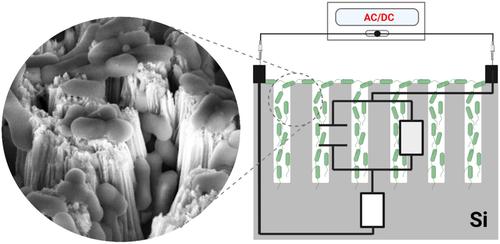Resistive Method for Bacterial Detection Employing a Silicon Nanowire Electrical Chip
IF 3.5
2区 生物学
Q2 BIOTECHNOLOGY & APPLIED MICROBIOLOGY
引用次数: 0
Abstract
There is now an urgent need to develop reliable, rapid, and cost-effective methods for bacterial detection, particularly for point-of-care applications. This study explores the unique properties of silicon nanowire (SiNW) arrays as a resistive sensing platform for detecting Listeria innocua. Vertically aligned SiNWs, fabricated via metal-assisted chemical etching, exhibited high sensitivity to bacterial adsorption. Conductance measurements revealed a more than 10-fold increase as bacterial concentrations rose from 105 to 107 CFU/mL, with clear saturation at higher levels. The study employed both direct current (DC) and alternating current (AC) methodologies, with AC conductance consistently outperforming DC due to reduced potential barrier effects. An equivalent circuit model was developed to describe the impedance behavior of the SiNW-bacteria system, offering valuable insights into charge transport mechanisms. These results demonstrate the potential of SiNW-based sensors as robust, scalable, and high-performance diagnostic tools. Beyond bacterial detection, the proposed platform offers promising applications in clinical diagnostics, environmental monitoring, and food safety.

求助全文
约1分钟内获得全文
求助全文
来源期刊

Biotechnology and Bioengineering
工程技术-生物工程与应用微生物
CiteScore
7.90
自引率
5.30%
发文量
280
审稿时长
2.1 months
期刊介绍:
Biotechnology & Bioengineering publishes Perspectives, Articles, Reviews, Mini-Reviews, and Communications to the Editor that embrace all aspects of biotechnology. These include:
-Enzyme systems and their applications, including enzyme reactors, purification, and applied aspects of protein engineering
-Animal-cell biotechnology, including media development
-Applied aspects of cellular physiology, metabolism, and energetics
-Biocatalysis and applied enzymology, including enzyme reactors, protein engineering, and nanobiotechnology
-Biothermodynamics
-Biofuels, including biomass and renewable resource engineering
-Biomaterials, including delivery systems and materials for tissue engineering
-Bioprocess engineering, including kinetics and modeling of biological systems, transport phenomena in bioreactors, bioreactor design, monitoring, and control
-Biosensors and instrumentation
-Computational and systems biology, including bioinformatics and genomic/proteomic studies
-Environmental biotechnology, including biofilms, algal systems, and bioremediation
-Metabolic and cellular engineering
-Plant-cell biotechnology
-Spectroscopic and other analytical techniques for biotechnological applications
-Synthetic biology
-Tissue engineering, stem-cell bioengineering, regenerative medicine, gene therapy and delivery systems
The editors will consider papers for publication based on novelty, their immediate or future impact on biotechnological processes, and their contribution to the advancement of biochemical engineering science. Submission of papers dealing with routine aspects of bioprocessing, description of established equipment, and routine applications of established methodologies (e.g., control strategies, modeling, experimental methods) is discouraged. Theoretical papers will be judged based on the novelty of the approach and their potential impact, or on their novel capability to predict and elucidate experimental observations.
 求助内容:
求助内容: 应助结果提醒方式:
应助结果提醒方式:


